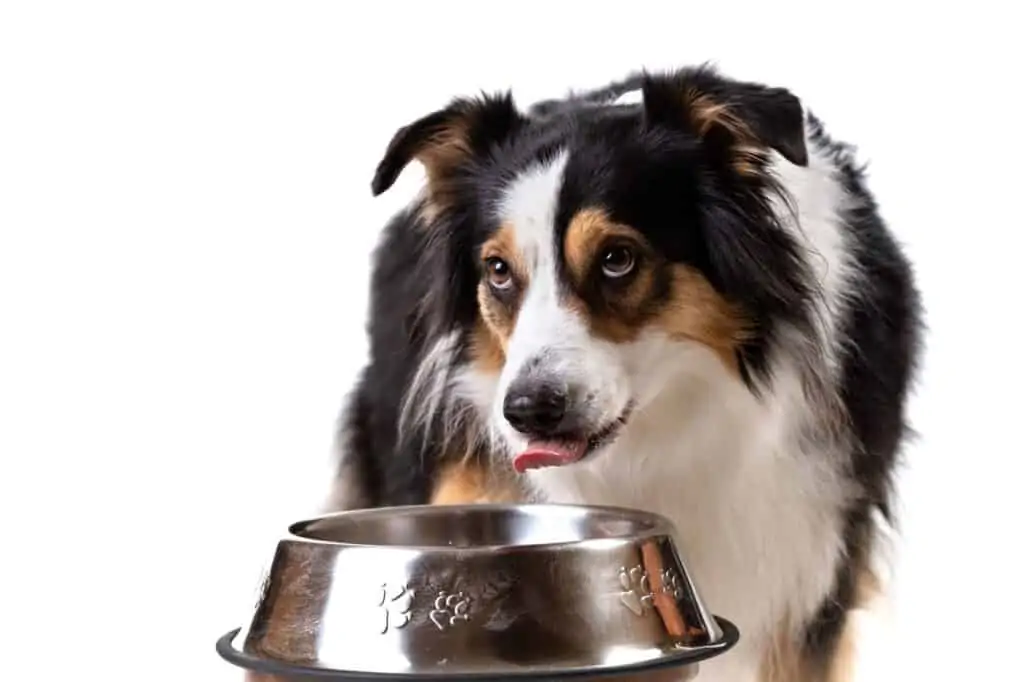Why Your Australian Shepherd Isn’t Fluffy? [Explained]
Australian Shepherds are known for their beautiful, lush coats that make them stand out among other dog breeds. However, if you’ve noticed that your Aussie isn’t as fluffy as you’d expect, you might be wondering why this is the case. In this article, we will explore the reasons behind your Australian Shepherd’s lack of fluffiness and provide insights on how to address them.
One possible reason for your Aussie not being as fluffy as you’d expect could be genetics. Not all Australian Shepherds have the same coat type, and some may inherit genes that result in a shorter or less dense coat. Alongside genetics, external factors like nutrition, grooming habits, and even climate can affect your Australian Shepherd’s coat.
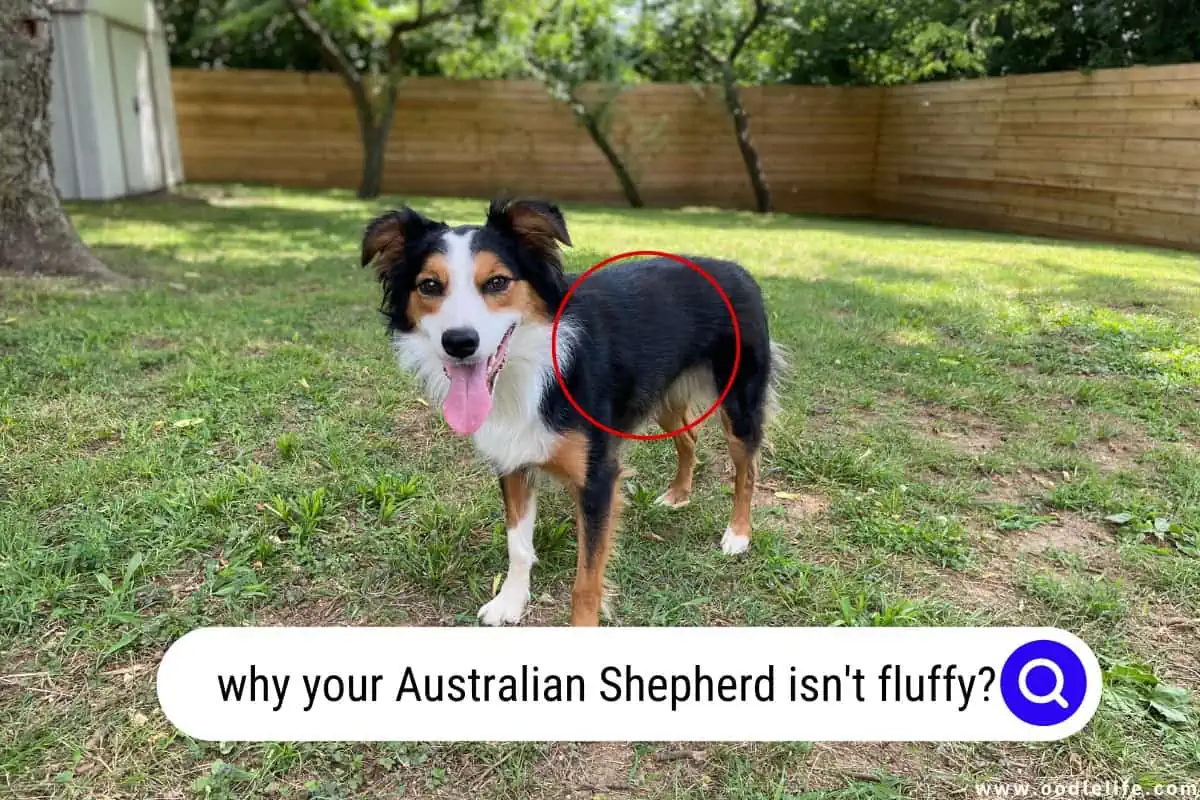
Taking care of an Australian Shepherd’s coat can be both exciting and challenging. By understanding the various factors that contribute to their fluffiness, or lack thereof, you will be better equipped to ensure your pupper looks and feels its best. So, let’s dive into the world of Australian Shepherd coat care and find out the secrets behind fluffy Aussies.
Genetics and Fluffiness
When it comes to the fluffiness of your Australian Shepherd, genetics play a significant role. In this section, we’ll explore the inherited coat types and gene variations responsible for your Aussie’s unique coat characteristics. So, let’s dive into the world of doggy genetics to better understand your Australian Shepherd’s coat.
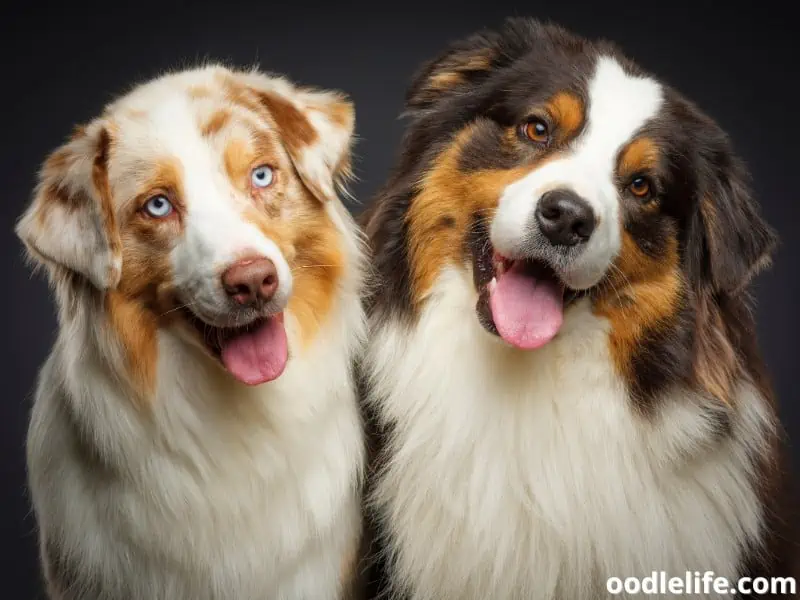
Inherited Coat Types
Australian Shepherds can have different coat types, ranging from short and smooth to long and fluffy. The specific type of coat an Aussie inherits is based on a combination of various genes passed down from its parents.
- Short and smooth coats are easier to maintain and can be more practical for outdoor and working dogs.
- Medium-length coats offer a mix of fluffiness and practicality, requiring moderate grooming and care.
- Long and fluffy coats are undoubtedly adorable, but they can be more challenging to manage due to increased shedding and grooming requirements.
In general, a fluffier Australian Shepherd inherits the genes responsible for a longer coat, while a less fluffy Aussie inherits those for a shorter coat.
Gene Variations
The expression of specific genes can lead to variations in coat length, texture, and overall fluffiness. One such gene is the “fiber length gene,” which influences the hair growth cycle. When this gene is expressed differently, it can result in a range of coat lengths and textures among Australian Shepherds.
Another gene, known as the “furnishings gene,” influences facial hair growth and the “fuzzy” appearance often seen in Aussies. Dogs with dominant furnishings genes tend to have more facial fluff, while those with recessive genes display a smoother, cleaner look.
In summary, the extent of your Australian Shepherd’s fluffiness is determined mainly by its inherited coat type and the unique combination of gene variations. So, if your Aussie isn’t quite as fluffy as you’d expect, you can blame it on its fascinating genetic makeup!
Grooming Practices
Keeping your Australian Shepherd’s coat looking fluffy and healthy can be as simple as following some essential grooming practices. In this section, we’ll discuss the brushes and tools you’ll need, proper brushing technique, and how to deal with mats.
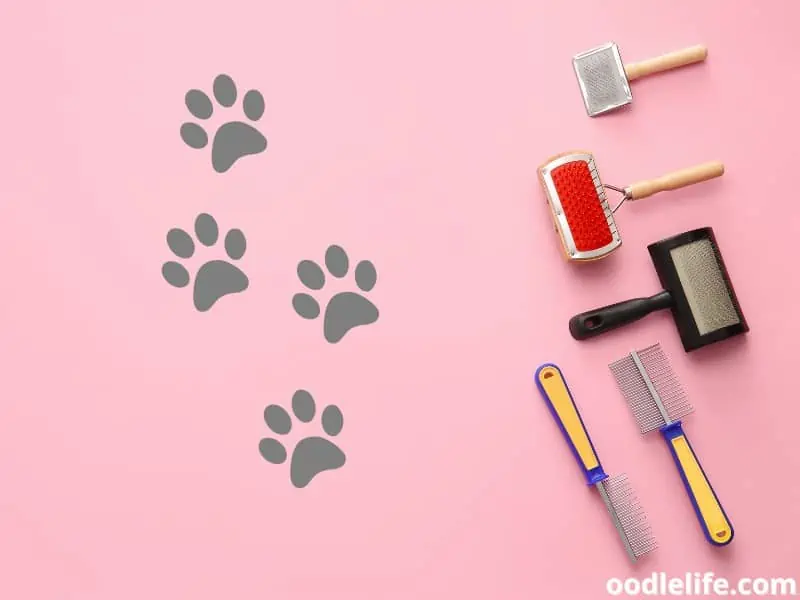
Essential Brushes and Tools
Your Aussie’s coat will require particular attention and the right grooming tools to keep it in excellent condition. Here is a list of essential brushes and tools:
- Slicker brush: This brush is perfect for removing loose hair and preventing mats.
- Undercoat rake: It helps to remove dead hair from the undercoat, promoting a healthy coat.
- Comb: A wide-tooth comb is useful for gently detangling the hair.
- Detangling spray: This can be applied before brushing to minimize knots and breakage.
Brushing Technique
It’s essential to have the right brushing technique when grooming your Australian Shepherd. Here are some steps to follow:
- Start with detangling spray: Apply a detangling spray to your dog’s coat, focusing on the more tangly areas.
- Begin with the undercoat rake: Gently use the undercoat rake to remove any loose hair from the undercoat.
- Move to slicker brush: Next, use the slicker brush to gently brush the coat to remove loose hair and prevent mats from forming.
- Finish with the comb: Finally, use the wide-tooth comb to check for and gently detangle any remaining knots.
- Brush in sections: To avoid missing any areas, separate the coat into sections and brush each one individually.
Dealing with Mats
Mats are clumps of tangled hair that can be uncomfortable for your Australian Shepherd and lead to skin irritation. Follow these steps to deal with them:
- Identify the mat: Locate the mat and separate it from the rest of the coat.
- Apply detangling spray: Apply some detangling spray to the mat to help loosen it up.
- Gently break apart the mat: Hold the mat firmly at the base, close to the skin, and use a comb or your fingers to tease apart the tangles, working from the tips toward the base.
- Comb through the area: Once the mat is gone, comb through the area to ensure all tangles have been removed.
Following these grooming practices will help keep your Australian Shepherd’s coat looking healthy and fluffy. Happy grooming!
Diet and Nutrition
When it comes to the fluffiness of your Australian Shepherd, diet and nutrition play an essential role. Ensuring your pup gets the right nutrients can help maintain a healthier and luscious coat. Let’s dive into the key elements of your Aussie’s diet.
Quality Ingredients
Always choose high-quality ingredients for your Australian Shepherd’s meals. Think of it like this; if you wouldn’t eat it yourself, it’s probably not the best choice. Opt for balanced and nutritious commercial dog food that contains:
- High-quality protein sources (e.g., chicken, beef, fish)
- Complex carbohydrates (e.g., whole grains, vegetables)
- Healthy fats (e.g., omega-3 and omega-6 fatty acids)
Supplements
While some Australian Shepherds may do well with high-quality commercial dog food alone, others may benefit from a few supplements to help improve the coat and make your pup fluffier. Some useful supplements include:
- Omega-3 fatty acids: These can be found in fish oil and are great for improving coat health and reducing inflammation.
- Biotin: Biotin can promote healthy skin, nails, and hair growth. It’s usually found in eggs, liver, and certain vegetables.
- Vitamin E: Known for its skin-rejuvenating properties, vitamin E can be found in plant-based oils and certain vegetables like spinach.
Remember to consult your veterinarian before introducing any supplements to your Aussie’s diet.
Hydration
Don’t underestimate the importance of hydration in maintaining a fluffy coat. Water plays a crucial role in your dog’s overall health, especially in keeping their skin moisturized and assisting in nutrient absorption. To ensure your Australian Shepherd stays well-hydrated:
- Always provide fresh, clean water.
- Encourage your pup to drink regularly, especially during hot weather.
- Monitor your dog’s water intake, and adjust as needed.
By focusing on these key aspects of diet and nutrition for your Australian Shepherd, you’ll be well on your way to getting that fluffiness you desire for your canine companion. Just remember, it takes time, patience, and a dose of love to achieve the ideal fluff!
Health Factors Affecting Coat
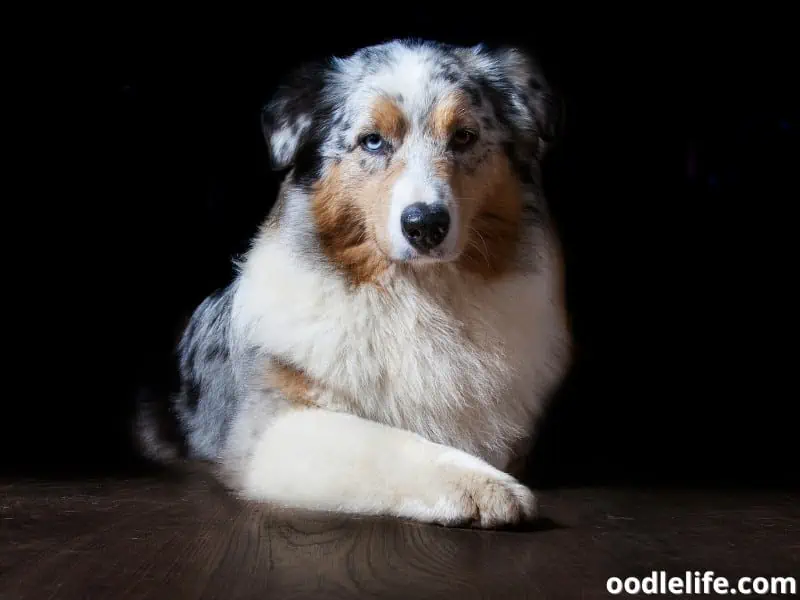
Hormonal Imbalances
One possible reason your Australian Shepherd isn’t fluffy might be due to hormonal imbalances. Just like humans, dogs can experience hormonal issues that affect their coat. For instance, hypothyroidism, a condition involving insufficient thyroid hormone production, can lead to hair thinning or slow growth.
Similarly, Cushing’s disease, caused by excessive cortisol production, may result in a thin, patchy coat. If you suspect your Aussie is dealing with a hormonal imbalance, it would be wise to consult a veterinarian for proper diagnosis and treatment.
Infections or Parasites
Sometimes, the culprit behind your Australian Shepherd’s lack of fluff is an infection or parasites. Fungal infections like ringworm can damage your dog’s fur, while parasites such as fleas, ticks, or mites can cause hair loss or disrupt its natural growth. Additionally, skin infections or allergies may lead to excessive scratching and, as a result, a less-than-fluffy coat.
To address these issues, maintain a vigilant eye for signs of infection or parasites and work closely with your vet. They’ll help ensure your Aussie stays healthy, happy, and closer to that fluffy dream coat we all know and love.
Remember, when it comes to your Australian Shepherd’s coat, health is paramount. While it’s tempting to chase the fluff, always prioritize the well-being of your furry companion over a perfectly plush appearance.
Environmental Factors
When trying to understand why your Australian Shepherd isn’t as fluffy as you’d like, there are several environmental factors to consider. These factors can affect the thickness and quality of your dog’s coat, which we will explore further in the following sub-sections.
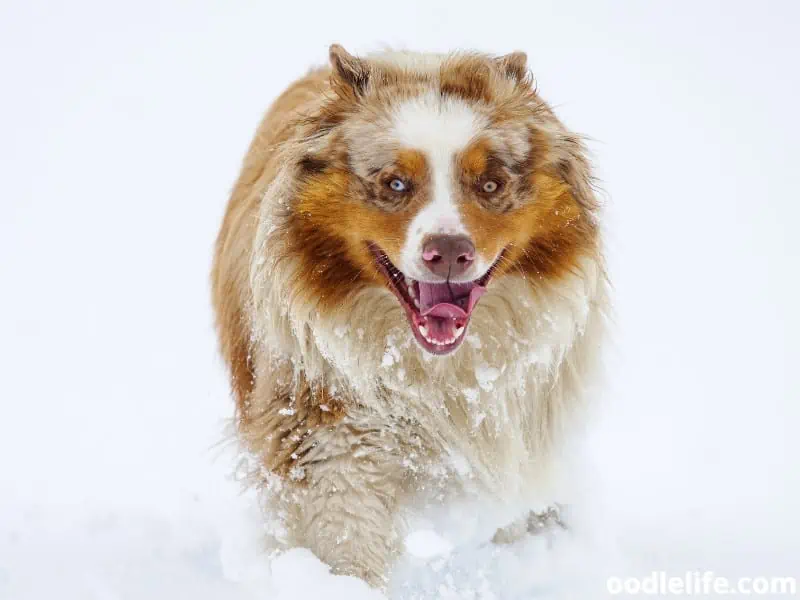
Weather and Seasonal Changes
Australian Shepherds are naturally equipped to handle various weather conditions due to their double coat. However, changes in weather and seasonal transitions can influence their fluffiness. For example, during the warmer months, they tend to shed their winter coat, which can result in a less fluffy appearance.
Additionally, prolonged exposure to excessive heat or cold might affect the overall health of your dog’s coat, leading to a less fluffy appearance.
Exposure to Allergens
Did you know that dogs, just like humans, can have allergies? Your Australian Shepherd’s lack of fluffiness might be a result of exposure to allergens, such as pollen, dust, or certain foods. Allergic reactions can lead to symptoms like skin irritations, itching, and even hair loss, which can cause your pup’s glorious fur to become less fluffy.
To identify potential allergens, it’s a good idea to visit a veterinarian who can help narrow down the list of potential culprits and provide appropriate treatment options. By managing your dog’s exposure to allergens, you’re taking steps towards maintaining their overall health and fluffiness.
In conclusion, it’s essential to consider the various environmental factors that may be affecting your Australian Shepherd’s fluffiness. By being mindful of weather and seasonal changes, as well as allergen exposure, you can help ensure your dog maintains a healthy, fluffy coat.
Conclusion
It can be frustrating when your Australian Shepherd doesn’t have that fluffy coat you envisioned. There are a few reasons why this can happen, and understanding them could help you come to terms with your furry friend’s appearance.
Firstly, genetics play a significant role in determining the fluffiness of your Aussie’s coat. Some individuals may inherit genes that result in a less fluffy appearance, and that’s perfectly normal. After all, who wouldn’t want to showcase the genes they got from their fabulous parents?
Next, factors such as your dog’s age, diet, and general wellbeing might contribute to the texture of their coat. Puppies usually don’t flaunt their full fluffiness until they’re older, so be patient with your little one. Meanwhile, ensure that they are consuming a diet rich in nutrients to promote a healthy coat.
Don’t forget that exercise and cuddles can contribute to overall wellbeing – we all know a happy dog is a beautiful dog!
Finally, various grooming practices can diminish your Australian Shepherd’s fluffiness. Regular brushing is essential in maintaining your pooch’s fluffy look, but be careful not to over-groom or use the wrong tools. Choosing the right brush for your dog’s coat type can make a whole world of difference.
In the end, their coat’s appearance is up to you and your grooming talent (or lack thereof).
By grasping the factors that impact your Australian Shepherd’s fluffiness, you’re now better equipped to cherish your furry friend, regardless of their coat’s floof level. As we all know, it’s what’s on the inside that counts – and Aussies are just as loveable and loyal, fluffy or not!
